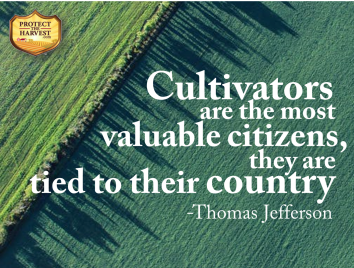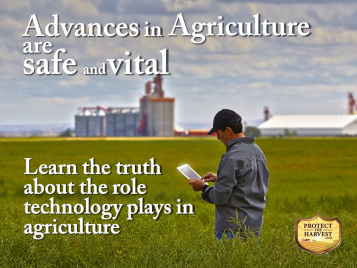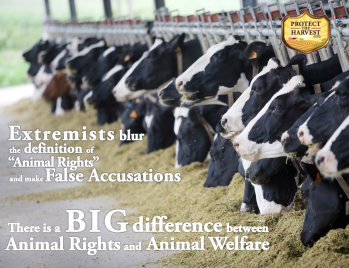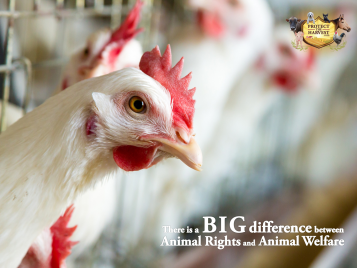
We are neighbors and friends – YouTube video
By 2050, it is expected that the world’s population will grow to nearly 9 billion; thus increasing our need for food by more than 100 percent. Currently, 1 in 8 people, or 842 million, struggle with hunger every day. Even more so, roughly 1 billion people in the world are food insecure, meaning they lack access to a sufficient quantity of affordable, nutritious food. While agriculture has evolved in order to meet these intensely growing food demands, farmers will need to increase food production by 70-100 percent to meet global nutrition needs.
We already know that there is relatively little available land on which to cultivate food. The Food and Agriculture Organization of the United Nations (FAO) projections indicate that 80 percent of the additional food required to meet demand in 2050 will need to come from land already under cultivation. The result is that our farmers and food producers must produce those higher yields using the same (or less) acreage than they use today while relying on fewer natural resources.

We are very fortunate in the United States to have a strong economy, a dedicated workforce, and good, diverse land from which to cultivate crops. In 2016, U.S. consumers spent only 10% of personal disposable income on food. However, there are still nearly 24 million Americans living in food deserts today, without ready access to affordable nutrition. These food deserts are not just in one area of the country; they exist throughout the United States.
The success of our country is dependent on the success of other countries. Consumers in other parts of the world must spend 50% or more of their income on food, and this is devastating for them. By providing people with the tools they need to lift themselves out of poverty, achieved by first fighting malnutrition, we create a more stable world. For every 5% drop in income growth in a developing country, the likelihood of violent conflict or war within the next year increases by 10%.

Humans have an innate desire to access more knowledge on a wide variety of subjects; biotechnology must be included in that. Farmers who utilize these modern agriculture techniques are contributing to our healthy, nutritious, and sustainable food supply. The more we can learn about biotechnology’s safety and applications in the real world, the more likely the general public will be to accept it as a major segment of agricultural production.
We are quietly losing our ability to provide affordable food for our nation. Farming and ranching are under attack in the United States, and so are your rights to feed your family. Extremist groups are working to control farming, ranching land use, water use and to restrict animal ownership.
Those involved in the “Food Elitist” and animal rights movements are focused on an ideology, insisting that others must comply with their ideals. In order to force the public to comply with their agenda, animal rights organizations, and their affiliated groups are relentlessly pushing new mandates and regulations that will ultimately both limit food options available to all Americans and limit the availability of affordable food. There is even a “think tank” group based in Washington D.C. that recommends a 40% tax on beef and a 20% tax on other meat products. Read more about it here: https://wattsupwiththat.com/2016/11/19/uk-researchers-tax-food-to-reduce-climate-change/
We need to protect our nation’s ability to produce food so that we do not become reliant on other countries to feed our nation. Our farmers and ranchers must be allowed to make decisions based on scientific reasoning and without being obstructed by non-governmental organizations (NGO’s) that know nothing about agricultural practices.
Animal rights and their affiliated groups have far-reaching tentacles. Not only are they attempting to end the use of animals in agriculture, but they are also misinforming the public about one of the most important developments in the history of food production: genetically modified organisms (GMOs).
Foods produced with genetically engineered (GE) crops are as safe and nutritious as organic products. They are sustainable; using fewer resources, like land and water, to produce greater yields. It is disheartening that our best hope to meet the world’s growing food demands is maligned by massive amounts of misinformation fed to the general public.
For more information on GMO’s, follow this link https://gmoanswers.com/
Here’s an article about a journalist who was one of the first to get involved in campaigns against GE crops. Since then, and after his own research, he has changed his mind: https://www.westernfarmpress.com/government/mark-lynas-leaves-anti-gm-fold-converts-science
When farmers plant genetically modified crops, they can produce more end product per acre. This is because GE crops have been designed to produce more and to be resistant to pests, weeds, and diseases. GE crops have also been produced to be drought tolerant, requiring less water. With the resistance coded in the genetics of the crops, farmers can use fewer pesticides and herbicides, leaving a lower environmental impact. As with golden rice, GE food can be engineered to provide greater nutritional value, so it is healthier to eat than its similar counterparts. And, the shelf life of GMOs can be extended for less waste. All of this increases the efficiency and production capacity of food producers, making it easier to feed the world.

The math is simple, improved breeding and cultivation leads to better yields and a positive impact on our food supply. We can also ensure that the animals we raise are maximized to their full potential by giving them proper nutrition in their feed (improved through biotechnology) and breeding them for desired traits. Selective breeding improves animals’ ability to convert feed to meat, milk, or fiber more efficiently, making the final product more nutritious. The proper management and attention to the welfare of animals in agriculture allows farmers and ranchers to provide better products to consumers. For example, modern housing systems streamline production while simultaneously improving animal welfare by protecting animals from disease, predation, fighting, and injury.
Combining science, new technologies, and best practices allows farmers and ranchers to continue to provide food for our nation and our world.
Here is just a small sampling of how animal rights groups have written, funded, and marketed legislation across the country. These new regulations have a devastating impact on agriculture, our economy, and ultimately on American families.
On January 1st, 2015, California saw two laws go into effect (Proposition 2 and AB 1437), which produced similar results as seen in Europe. Due to Prop 2, many egg producers have left the state of California, and the price of eggs has skyrocketed. In addition to the impact on California egg farmers, lower-income families who consume one of the most affordable forms of protein in eggs, face the biggest burden of Prop 2 at the supermarket.
Not content just to pass these regulations in California, the HSUS hatched an unsuccessful scheme to force these regulations on egg farmers nation-wide. They even tried to sneak this provision into the 2013 Farm Bill.
Find more information through these links:
Article HSUS Federal Egg Mandate Suffers Major Set Back
In Massachusetts, the Humane Society of the United States and their affiliated animal rights groups pushed similar and more expansive regulations to Prop 2 in California. Due to deceptive advertising, Massachusetts Question 3 passed in November of 2016. Massachusetts Question 3 will drive up the cost and reduce the availability of eggs, meat, and pork.
Because the true agenda of animal rights organizations is to eliminate animal agriculture, the Humane Society of the United States and their affiliated groups were not satisfied with the changes they forced onto California farmers and consumers with Prop 2. Therefore, before Prop 2 fully implemented, they wrote, funded and marketed new legislation that impacts the sale of egg, pork, and veal products in California. Prop 12 mandates that California egg, pork and veal producers and any out of state producers wishing to sell their products in California meet their requirements. The HSUS and their affiliated groups spent $13,000,000 deceiving the public about the true agenda of Prop 12 and it was voted into law, November 2018.
Click on the following links for more information:
Information about Animal Welfare in Large Modern Farms
Using their sizeable bank accounts, and finely-honed public personas, animal rights groups have pressured numerous restaurants and grocery stores to change how they source food. These organizations force the family farms that supply their food to agree to non-scientific, and often counterproductive, animal care standards. This creates a massive hardship for the farming families that rely on this business, and it drives up the cost of food for American consumers and has even led to shortages in food availability.
Here are links to articles with additional information:
McDonalds Decision – Not Lovin It
HumaneWatch Files Complaint with IRS Against HSUS
These groups have also used “shareholder advocacy” to control the animal care practices of American producers. They buy up significant shares in American food companies, and then use those shares to try to force the boards of those companies to adopt their agenda.
Link to more information:
HSUS Uses Power in American Economy
It’s important to note that the animal care standards these groups insist on do NOT improve the welfare of animals. In many cases, their mandates lead to higher instances of mortality through injury, predation, and disease.

For more information about modern farming practices and how they benefit the welfare of animals in agriculture follow:
Article – New Study Finds Hens Safer in Cages than Cage Free Systems
Link to Protect California Families Resources Tab
There was a time we celebrated the pioneers who helped make our food supply more sustainable, nutritious, and abundant. Now non-governmental organizations use fear tactics to weaken America’s trust in agriculture. In a nutshell, what drives most of the hysteria surrounding the use of technology to improve food production is that we fear what we don’t know. Those who oppose advances in agriculture, such as genetically modified foods, fail to realize the advances are not only safe but vital.
Below are some truths about GE crops:
Thousands of studies, many of these independent, have been conducted in order to evaluate whether genetically modified foods are safe for consumption. The majority of these studies found genetically modified crops pose no true threat to human health.
The largest-ever comprehensive study of GMOs and food, conducted by researchers the University of California-Davis Department of Animal Science, found that genetically modified feed is safe and nutritionally equivalent to non-GM feed. Pouring through data on livestock productivity and health from before and after the introduction of genetically engineered animal feed, researchers saw that over 100 billion animals experienced no real change in health trends over that period.
Dr. Steven Novella, who examines this research, perfectly summarizes the results of the data collected over several decades on the subject of GMO safety:
“We now have a large set of data, both experimental and observational, showing that genetically modified feed is safe and nutritionally equivalent to non-GMO feed. There does not appear to be any health risk to the animals, and it is even less likely that there could be any health effect on humans who eat food items and products derived from those animals. In order to maintain the position that GMOs are not adequately tested, or that they are harmful or risky, you have to either cherry pick a few outliers of low scientific quality, or you have to simply deny the science.”
Those involved in the anti-GMO movement make the false claim that GE crops are “worse for the environment.” In reality, GMOs are good for the environment in many ways:
The term “Big Agriculture” was created by special interest non-governmental organizations (NGO’s) to distort the public’s view of agriculture. Research is expensive, time-consuming and often occurs due to the support of larger companies. There is nothing wrong with agricultural companies investing in research. It is good business practice, and the results of research and emerging technologies help both large and small farms produce affordable food. In addition to research studies funded by large organizations, there are thousands of independent, peer-reviewed GMO studies that have found genetically engineered crops and foods are safe.
The World Health Organization, the American Association for the Advancement of Science, and dozens of other distinguished medical and scientific groups worldwide approve of GE-GMO use as well.
Before the modern age, farming, in large part, was a guessing game. Farmers knew that it was good to put manure in the ground and that if you stayed in one place for too long, the soil could lose its ability to produce, but that’s about it. Farming has changed significantly since the dawn of agriculture. Through science and research, we have learned to measure, test, and distribute water and nutrients in the most efficient way possible. The ability to measure moisture, pH, phosphorus, potassium, calcium and magnesium levels tell us exactly what is needed to make crops grow. Farmers also know which crops will grow best where, how to make the environmental impact as low as possible, and how to best retain soil nutrients over time. Today’s farmer can control every nuance of their land. Often, this information can be sent directly to one’s mobile phone for the sake of convenience.
Farmers and ranchers care about their animals and put their welfare first and foremost. Not only is focusing on animal welfare the right thing to do, but farmers and ranchers rely on their animals to support their families. Animal rights ideologues, who believe that animals should not be utilized by humans in any way, view animals living in close proximity as abuse. In reality, modern farming practices are followed to ensure greater health and well-being of the animals. Animal rights groups demand farmers change how they practice animal husbandry, without caring that doing so has harmful effects on the animals. In cage-free systems, animals are more exposed to a greater risk of disease, as well as predatory attacks, cannibalism, parasites, and bone breaks.
Farmers and ranchers work to constantly improve, utilizing both the latest techniques in animal husbandry and best practices passed down through generations.

© 2023 Protect The Harvest. All Rights Reserved
StoryBrand Website design by Results and Co.